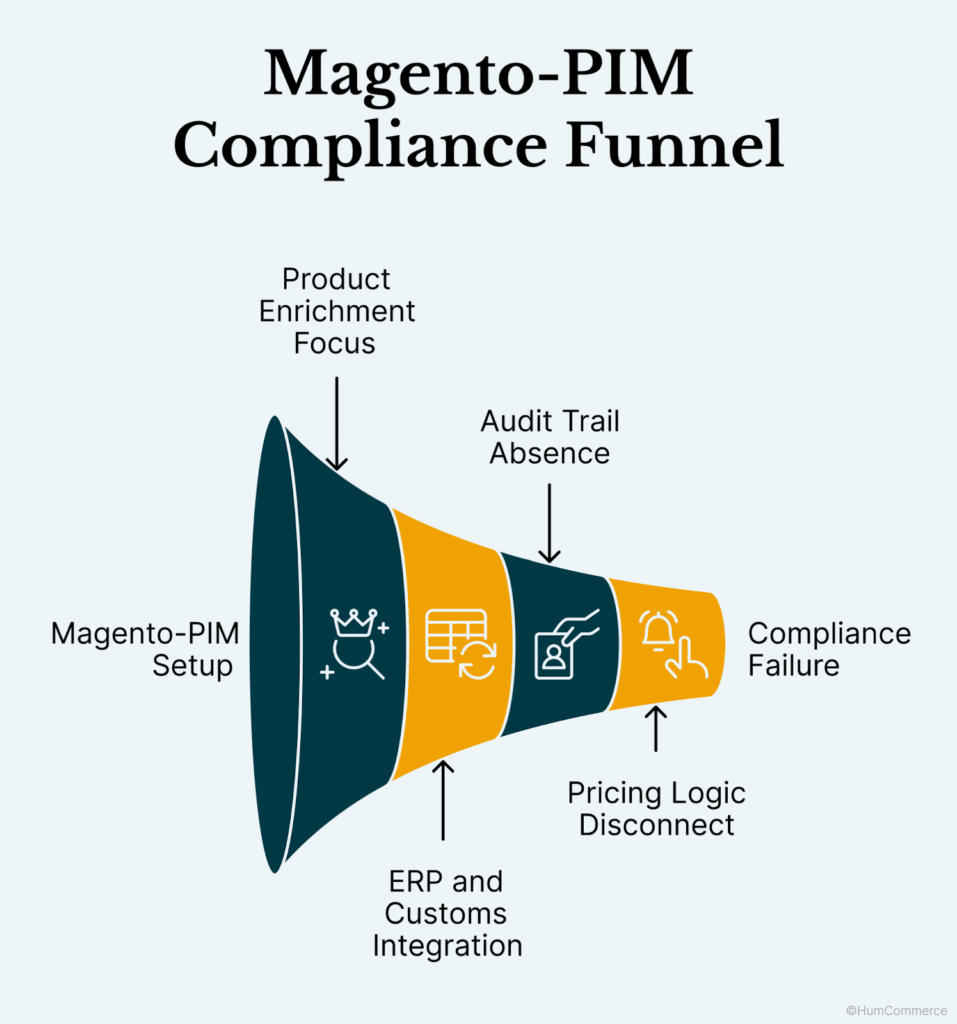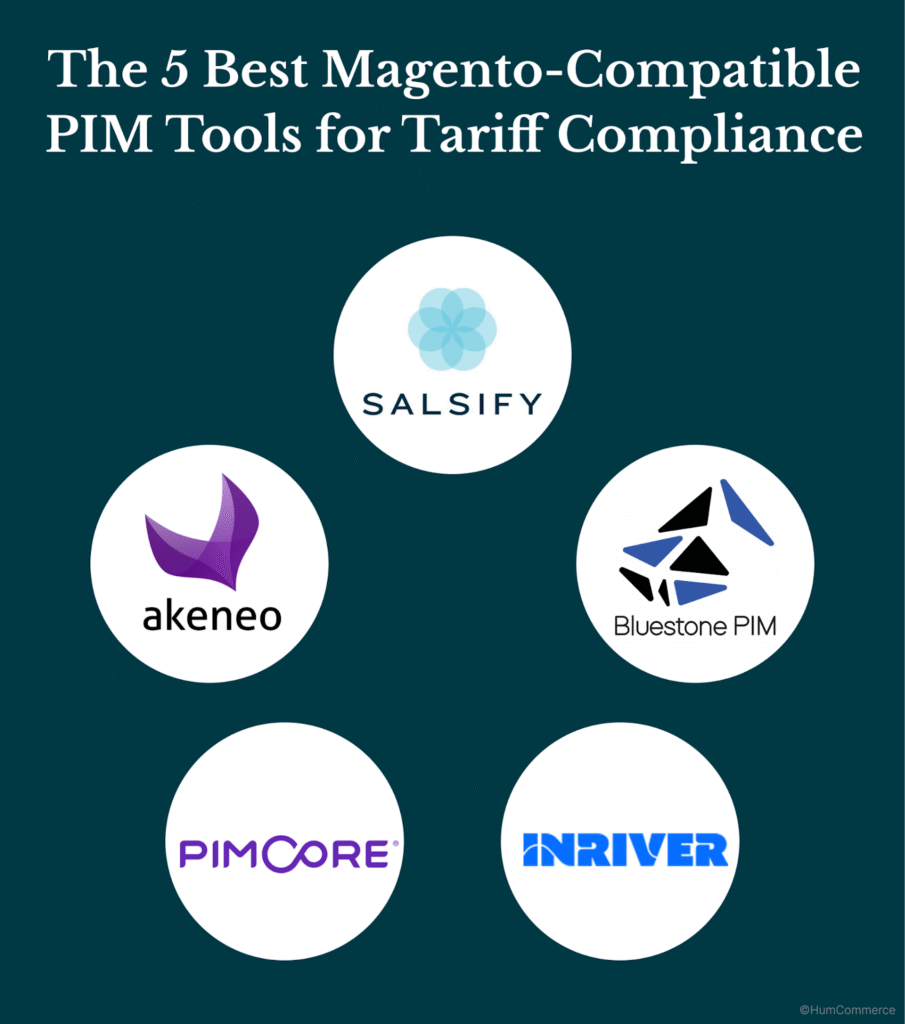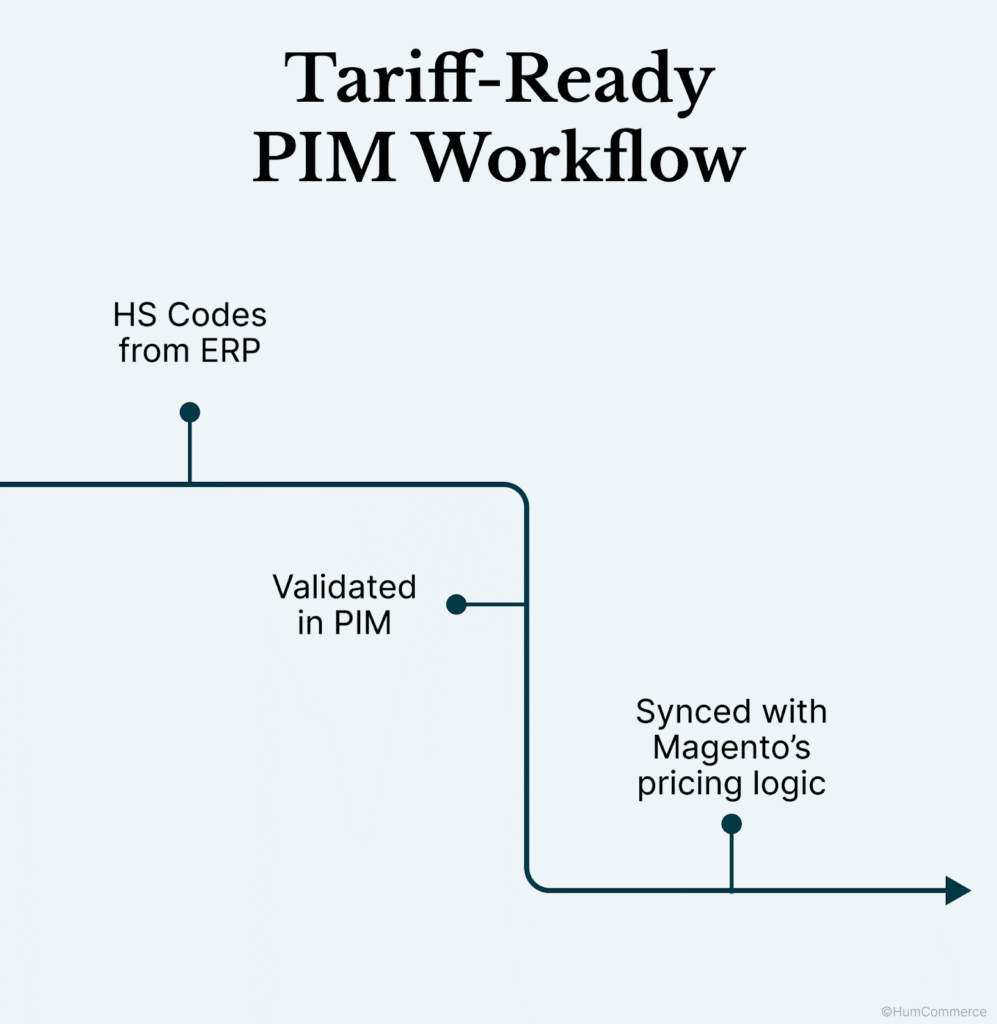Key Takeaways
- Understand why most Magento-PIM integrations aren’t built for tariff compliance
- Learn what tariff-specific attributes (like HS codes) must flow through ERP → PIM → Magento
- See how leading tools like Akeneo and Salsify manage 100K+ SKUs with regulatory precision
- Discover how CPQ pricing rules depend on accurate, synced product data
- Explore the role of middleware in flagging missing or invalid compliance fields
- Get a practical checklist for evaluating if your current setup can scale with trade volatility
You’ve got a tariff strategy. You’ve got a sourcing plan.
But if your product data still sits in disconnected spreadsheets or PIM setups designed for marketing teams, your ERP doesn’t stand a chance when customs hits back.
Here’s the silent killer:
Tariff risk lives in your catalog.
– A missing country-of-origin field
– An outdated HS code
– A component mismatch between Magento and ERP
Every one of those slips can inflate your landed cost without ever showing up as a system error.
And in industrial commerce, where you’re managing 250,000+ SKUs across bonded zones, vendor contracts, and CPQ workflows, one wrong data point doesn’t just trigger a penalty. It breaks trust, compresses margins, and stalls reorders.
That’s why the smartest Magento-ERP stacks today don’t just sync inventory and pricing.
They push tariff-ready product data from PIMs like Akeneo and Salsify into every system that needs to know in real time.
Where Compliance Hides in Your Product Catalog
When people think of tariff compliance, they imagine trade lawyers, customs brokers, and audit trails.
But for most industrial eCommerce leaders, the real friction point starts way earlier inside the PIM.
Because tariff compliance isn’t just a legal issue. It’s a data issue.
Here’s where things go wrong:
- Missing HS codes in the PIM → Customs delay
- Inconsistent country-of-origin data → Overpaid duties
- Unlinked components and assemblies → Inaccurate BOM valuation
- Attribute gaps between ERP and Magento → Incorrect pricing or reclassification risk
Let’s say you’re using Akeneo for enrichment, but tariff-specific fields aren’t normalized across your SKUs. Or worse, they’re not passed downstream to ERP or Magento.
That means your quote engine can’t price correctly. Your CPQ logic breaks. And your CFO never sees the duty refunds you could’ve claimed.
And when you’re managing SKU catalogs in the hundreds of thousands, these aren’t edge cases, they’re margin killers hiding in plain sight.
That’s why tariff compliance starts not in legal or ops, but in how your PIM is structured and integrated.
Why Most Magento-PIM Setups Fall Short on Tariff Compliance
Most industrial suppliers use PIMs to get their product data in order. Clean up attributes. Push consistent SKUs to Magento.
Great start but not nearly enough.
Because when tariffs change mid-quarter, compliance isn’t about consistency. It’s about traceability, audit readiness, and synced systems.

Let’s break down where most setups miss the mark:
1. They’re built for product enrichment, not regulation
Platforms like Akeneo, Salsify, and others are excellent at handling descriptions, images, and marketing tags. But global trade compliance? That’s not what they were designed for.
Try finding structured fields for HS codes, COO, ECCNs — let alone logic to flag mismatches.
Most teams end up using custom fields, sticky notes, or worse — spreadsheets.
That’s not just messy. It’s risky.
2. There’s no sync with your ERP or customs validation
Your ERP might say “Country of Origin: Mexico.”
Your PIM says “USA.”
Which one gets pushed to Magento? Who’s checking?
Without two-way validation between your ERP and PIM, it’s easy for product data to drift.
And when customs authorities audit that SKU, you need more than best guesses. You need records.
That’s where smarter Magento ERP integration comes in tying together systems so errors get caught early, not after they cost you.
3. No audit trail = no defense in an audit
Here’s the reality: compliance data changes. A tariff code gets revised. A supplier updates their COO documentation.
But most PIM integrations don’t log who changed what, or when. So when auditors ask for the paper trail, there isn’t one.
For companies managing 250K+ SKUs, that’s not a small oversight, it’s a major liability.
4. PIM → Magento sync stops before pricing logic
Even when the right tariff data lives in your PIM, it rarely flows into Magento’s pricing rules.
So your catalog may look perfect — while your quotes are still based on old costs.
If you’re serious about cost automation and staying compliant, your PIM needs to talk to both the ERP and Magento’s pricing engine. That’s where CPQ pricing rules and contract logic can truly come into play.
Bottom line: most Magento-PIM setups weren’t built for global trade volatility.
But with the right integration architecture, your product data can do a lot more than populate a page, it can protect margins and compliance too.
The 5 Best Magento-Compatible PIM Tools for Tariff Compliance
Choosing a PIM for Magento isn’t just about managing product data anymore.
If you’re handling thousands of SKUs across multiple countries and tariffs are constantly shifting, you need a PIM that does more than just organize your catalog. You need one that speaks compliance.
We’ve seen too many B2B teams pick PIM tools based on features like drag-and-drop UI or image support only to realize six months in that their setup can’t handle real-world trade rules.
Here are five Magento PIM tools that don’t just manage product data—they help you stay ahead of tariff changes, SKU risk, and compliance complexity.

1. Akeneo
Why it’s a strong choice:
Akeneo is often the first name that comes up when talking about Magento PIM integration and for good reason. It’s flexible, well-documented, and has strong community support. Supports CSV/XLSX bulk imports and native API rate-throttling logic for high-SKU volumes. For 250K+ SKU deployments, HumCommerce configures cron-based sync jobs with delta detection and fallback queues.
Good for: Open-source teams that want control, and have someone technical on board.
What to watch for: You’ll need to build custom connections to your ERP to surface things like tariff-based pricing or landed cost.
2. Salsify
Why it stands out:
Salsify was built for omnichannel retail, but industrial teams are adopting it fast, especially those that need strong governance across distributed teams. Its workflows make it easier to control how product attributes (like tariff flags or sourcing zones) change before they reach Magento.
Good for: Ops teams managing SKUs across multiple storefronts or marketplaces.
What to watch for: It doesn’t handle ERP pricing rules or CPQ logic out of the box, so that part will still sit elsewhere.
3. Pimcore
Why it fits complex stacks:
If your product data is messy, multi-layered, and spread across PDFs, images, and databases, Pimcore helps bring it all together. It’s also highly customizable, ideal for teams managing kits, configurable parts, or global SKUs with country-specific regulations.
Good for: Teams with complex catalogs and multiple regions.
What to watch for: It’s powerful, but not lightweight. Be ready to invest in a longer setup.
4. inRiver
Why it helps with compliance:
inRiver lets you segment your catalog based on market, language, or compliance zone super helpful if you’re managing SKUs across different tariff regimes. You can also track who changed what, when which makes audits a lot less painful.
Good for: Companies balancing marketing flexibility with regulatory accuracy.
What to watch for: Magento connectors exist, but some integrations may need middleware to be production-ready.
5. Bluestone PIM
Why it’s a rising favorite:
Bluestone is newer to the game but designed for real-time operations. If your SKUs change often and you’re pushing updates across Magento, ERP, and WMS, this one’s worth a look. It’s built API-first, which means you can sync pricing, tariff attributes, and product changes without waiting for manual exports.
Good for: Fast-moving industrial teams that want a clean, connected stack.
What to watch for: It’s not as widely adopted as Akeneo or Pimcore yet so community support is limited.
If You Only Remember One Thing…
When evaluating PIM platforms, most teams ask “Can this enrich my data?”
The better question is: “Can this keep me compliant when tariffs shift?”
Magento ERP integration only works if your PIM plays its part. That means syncing product specs, tariff attributes, and pricing rules across the stack automatically.
Want to see how this works in real workflows? The full eBook breaks down side-by-side comparisons, compliance use cases, and implementation tips.
Tariff-Ready PIM Architecture: What Integration Actually Looks Like
Most PIM implementations stop at product enrichment. But when you’re dealing with industrial trade complexity, that’s only half the story.
To make your PIM stack truly tariff-ready, it needs to sit at the intersection of three moving systems: Magento, ERP, and customs data.
So what does that architecture actually look like?

ERP → PIM: Feeding the Source of Truth
Your ERP already holds essential trade data—HS codes, country of origin, tariff exemptions, and supplier pricing clauses. But that information rarely reaches Magento in real time.
The fix?
Set up a continuous sync where ERP pushes validated attributes directly into your PIM fields. These aren’t just tags. They inform how products are priced, routed, and displayed, especially when tariffs change mid-cycle.
In enterprise setups, we use tariff APIs (e.g., USITC or EU TARIC) to fetch HS code revisions dynamically. These flow into ERP master tables and are validated against country-specific rules before surfacing in Akeneo.
PIM → Magento: Triggering Pricing Rules in CPQ Engines
Once your PIM has the right tariff attributes, the next step is enabling CPQ pricing rules in Magento. This means:
- Mapping tariff-based cost bands to customer-specific price tiers
- Adjusting SKU pricing based on duty-exempt status
- Flagging items that require bonded warehousing logic
The best PIM systems (like Akeneo or Pimcore) allow for field-level automation that syncs directly with Magento 2 CPQ modules.
No manual overrides. No spreadsheet uploads.
Just clean, dynamic pricing tied to real-world data.
The Middleware Role: Catching What Falls Through the Cracks
No system is perfect. That’s why your middleware layer matters.
Middleware tools catch:
- Invalid HS codes
- Missing country-of-origin fields
- Attribute mismatches between ERP and Magento
Middleware acts as a customs compliance buffer validating fields like ECCNs, COO mismatches, or tariff exemption logic before they go downstream.
Think of this as a real-time audit trail. If compliance data is incomplete or out of sync, middleware flags it before it causes a pricing error or worse, a customs penalty.
This is where Magento PIM integration goes from “nice to have” to “mission critical” for global trade.
Who Should Prioritize This Setup?
Not every company needs tariff-specific PIM logic on day one. But if you see yourself in any of the scenarios below, now’s the time to re-evaluate your stack.
Signs You’re Due for an Upgrade
- You’re managing 100K+ SKUs across multiple product types
- Your catalog spans 3+ customs zones, each with different duty rates
- You’re reclassifying products frequently due to material, vendor, or use-case changes
- Manual data cleanup is slowing down your Magento ERP integration workflows
- You’re still handling cost automation and compliance in spreadsheets
For catalogs exceeding 250K SKUs, Magento PIM integration needs to account for real-time sync stress, bulk data pipelines, and indexing latency.
You’ll need systems that can batch-update tariff attributes without crashing under volume and an architecture that keeps Elasticsearch, MySQL, and your pricing engine in sync.
Bonus Criteria
- You sell kits or bundles where tariff rules vary by component
- You’ve expanded sourcing to multiple countries post-2020 and now face reclassification issues
- Your compliance team and eCommerce team work in silos (and miss things)
Conclusion: Your Product Data Is a Compliance Weapon
Your PIM isn’t just about faster enrichment anymore. In the face of tariff volatility, it’s your first line of defense.
When your product data is compliant, synchronized, and dynamically tied to your pricing engine—you don’t just respond faster. You protect margin, avoid penalties, and ship with confidence.
Most Magento PIM integrations are built for enrichment, not enforcement.
HumCommerce goes further by embedding compliance protocols, customs validations, and tariff automation at the data level. Whether you’re handling 50K or 500K SKUs, our stack scales without breakdowns — something off-the-shelf connectors can’t guarantee.
If your current setup can’t handle customs volatility, cost automation, and SKU governance at once, it’s time to re-architect with compliance at the core.









